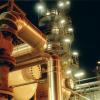hi,
i am a trainee operator in a refinery. please tell me how we covert the demulsifier/caustic/philmplus flow rate in ppm.
|
|
How To Convert Demulsifier/caustic/philmplus Rate In Ppm?
Started by naimatullah84, Apr 26 2009 06:33 AM
3 replies to this topic
Share this topic:
#1

Posted 26 April 2009 - 06:33 AM
#2

Posted 27 April 2009 - 05:08 AM
hello ,
You need to help us and define your query in detail . PPM stands part per million (1e-06) . PPM could be gram/ ton or gram/h / ton/h in case of mass flowrate.
Hope it helps.
Breizh
You need to help us and define your query in detail . PPM stands part per million (1e-06) . PPM could be gram/ ton or gram/h / ton/h in case of mass flowrate.
Hope it helps.
Breizh
#3

Posted 04 May 2009 - 11:02 AM
[quote name='breizh' date='Apr 27 2009, 03:08 PM' post='28692']
hello ,
Thanks breizh
I want to inject demulsifier @ 3-5 ppm of crude feed.
How can i calculate and regulate the correct amoumt of chemical injection in crude during my shift duty.
Please explain it briefly.
hello ,
Thanks breizh
I want to inject demulsifier @ 3-5 ppm of crude feed.
How can i calculate and regulate the correct amoumt of chemical injection in crude during my shift duty.
Please explain it briefly.
#4

Posted 05 May 2009 - 08:21 AM
Taking ppm to mean mass related, as I think is the common usage for this type of application, you must first convert your crude feedrate into a mass flowrate. So if you have a crude feedrate in say barrels per day (BPD) and you know its density (degrees API), then you must convert that volumetric flowrate * density to a mass flowrate. If you also have a flowrate and concentration for the demulsifier, then you get the mass flowrate of the demulsifier by multiplying the solution (mixture) flowrate * mass fraction of demulsifier in the mixture.
Though this would be considered a very simple calcaulation for a degreed chemical engineer, still it is rather difficult to describe in words. What makes it especially difficult is the fact that I'm given no information about any of the important flowrates or concentrations or densities. So I must address this in the most general way possible. While making my task very difficult, the value of the response is greatly decreased by the need to talk in generalities. For a better quality response, please fully define your system and the key variables. BTW, your best response might well be to talk to one of your plant engineers about this problem and seek his/her help.
Though this would be considered a very simple calcaulation for a degreed chemical engineer, still it is rather difficult to describe in words. What makes it especially difficult is the fact that I'm given no information about any of the important flowrates or concentrations or densities. So I must address this in the most general way possible. While making my task very difficult, the value of the response is greatly decreased by the need to talk in generalities. For a better quality response, please fully define your system and the key variables. BTW, your best response might well be to talk to one of your plant engineers about this problem and seek his/her help.
Similar Topics
Calculating Gas Flow Rate Without CvStarted by Guest_worrier_* , 25 Nov 2025 |
|

|
||
Wet Scrubber Design For Low Flow Rate Of GasStarted by Guest_SIVAMOORTHY_* , 17 Apr 2018 |
|

|
||
Teg Dehydration Stripping Gas Flow RateStarted by Guest_SidRah_* , 20 Aug 2025 |
|

|
||
How To Estimate The Circulation Rate For Amdea (Mdea 45Wt + Pz 5Wt) BeStarted by Guest_tokotof_* , 29 Nov 2024 |
|

|
||
Psv Release Rate Vs TimeStarted by Guest_stu_* , 30 Nov 2024 |
|

|

 FB
FB








